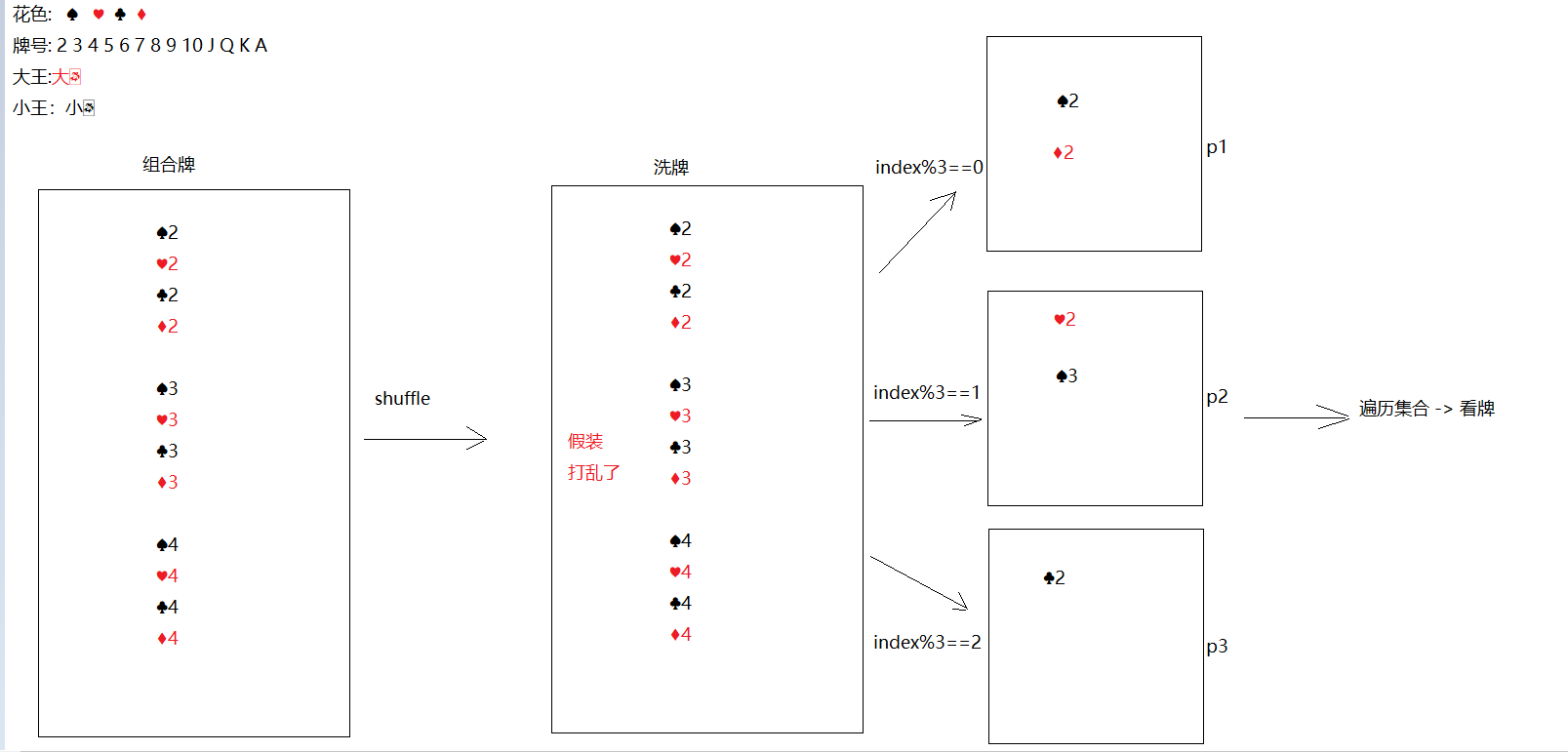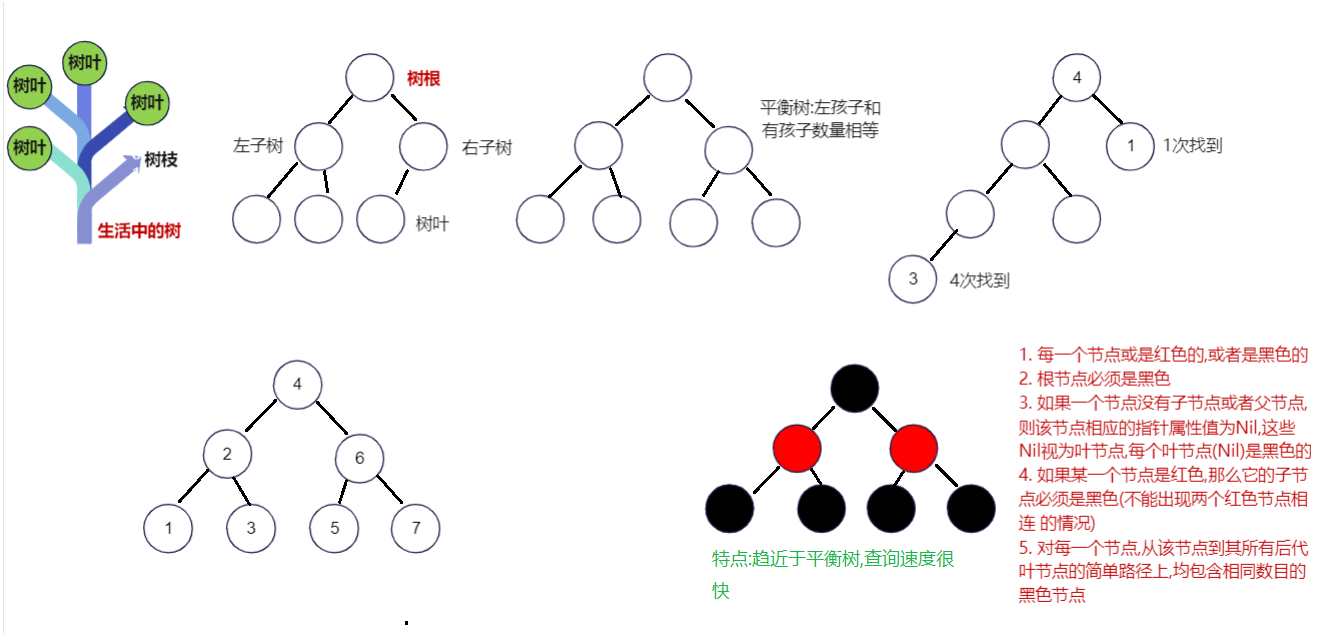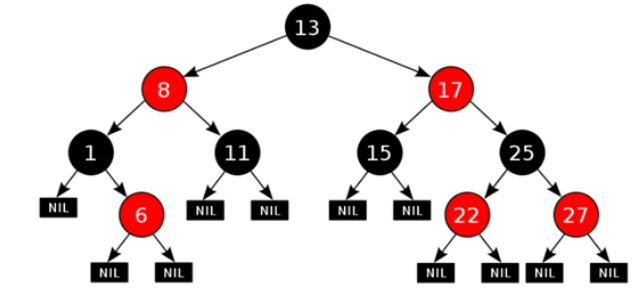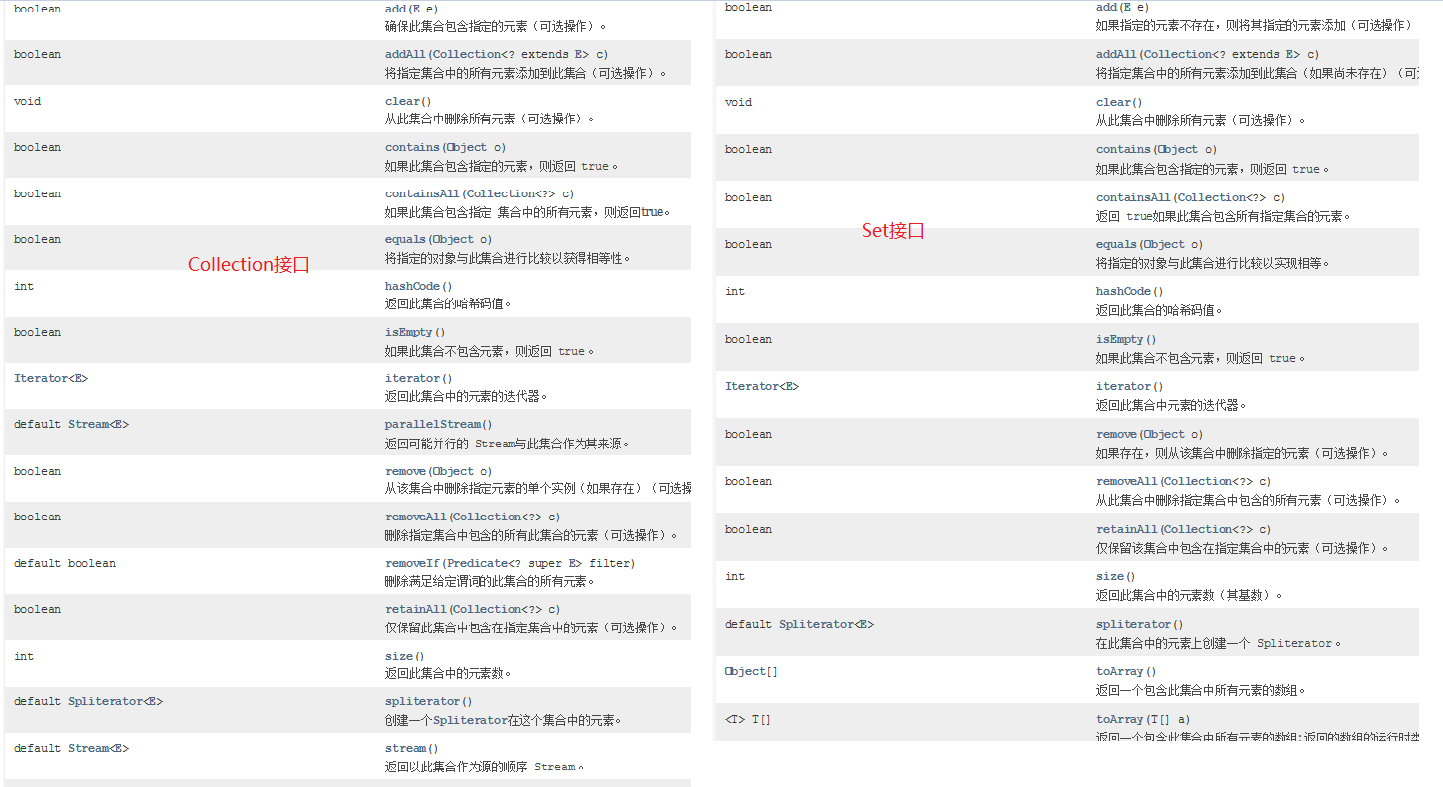模块19.集合
1
2
3
4
5
6
7
8
9
10
11
12
13
14
15
16
17
18
19
20
21
22
23
24
25
26
27
28
29
30
31
32
33
34
35
36
37
38
39
40
41
42
43
44
45
46
47
48
49
50
51
52
53
54
55
|
模块18回顾:
1.Collection集合:单列集合的顶级接口
a.add addAll clear size isEmpty remove toArray contains
2.迭代器:Iterator
a.获取:iterator方法
b.方法:
hasNext()
next()
c.并发修改异常:在迭代集合的时候,不能随意修改集合长度
原因:调用add,只给实际操作次数+1.后面调用next的时候,没有给预期操作次数重新赋值,导致预期操作次数和实际操作次数不相等了
3.数据结构:
栈:先进后出
队列:先进先出
数组:查询快,增删慢
链表:查询慢,增删快
4.ArrayList
a.特点:
元素有序,有索引,元素可重复,线程不安全
b.数据结构:
数组
c.方法:
add(元素)直接在最后添加元素
add(索引,元素)在指定索引位置上添加元素
remove(元素)删除指定元素
remove(索引)按照指定索引删除元素
size()获取元素个数
get(索引)根据索引获取元素
set(索引,元素)将指定索引位置上的元素修改成我们指定的元素
d.利用无参构造创建集合对象,第一次add时,会创建一个长度为10的空数组
超出范围,自动扩容->Arrays.copyOf
扩容1.5倍
5.LinkedList
a.特点: 元素有序 有索引(java提供了按照索引操作元素的方法,并不代表本质上拥有索引),元素可重复,线程不安全
b.数据结构:双向链表
c.方法:有大量直接操作收尾元素的方法
6.增强for:
a.格式:
for(元素类型 变量名:集合名或者数组名){
变量就代表每一个元素
}
b.原理:
遍历集合时,原理为迭代器
遍历数组时,原理为普通for
模块19重点:
1.会Collections集合工具类的常用方法
2.会使用泛型
3.知道HashSet和LinkedHashSet的特点以及使用
4.知道HashSet将元素去重复的过程
|
第一章.Collections集合工具类
1
2
3
4
5
6
7
8
9
10
11
12
|
1.概述:集合工具类
2.特点:
a.构造私有
b.方法都是静态的
3.使用:类名直接调用
4.方法:
static <T> boolean addAll(Collection<? super T> c, T... elements)->批量添加元素
static void shuffle(List<?> list) ->将集合中的元素顺序打乱
static <T> void sort(List<T> list) ->将集合中的元素按照默认规则排序
static <T> void sort(List<T> list, Comparator<? super T> c)->将集合中的元素按照指定规则排序
|
1
2
3
4
5
6
7
8
9
10
11
12
13
14
15
16
17
18
19
|
public class Demo01Collections {
public static void main(String[] args) {
ArrayList<String> list = new ArrayList<>();
//static <T> boolean addAll(Collection<? super T> c, T... elements)->批量添加元素
Collections.addAll(list,"张三","李四","王五","赵六","田七","朱八");
System.out.println(list);
//static void shuffle(List<?> list) ->将集合中的元素顺序打乱
Collections.shuffle(list);
System.out.println(list);
//static <T> void sort(List<T> list) ->将集合中的元素按照默认规则排序-> ASCII码表
ArrayList<String> list1 = new ArrayList<>();
list1.add("c.举头望明月");
list1.add("a.床前明月光");
list1.add("d.低头思故乡");
list1.add("b.疑是地上霜");
Collections.sort(list1);
System.out.println(list1);
}
}
|
1
2
3
4
5
6
7
|
1.方法:static <T> void sort(List<T> list, Comparator<? super T> c)->将集合中的元素按照指定规则排序
2.Comparator比较器
a.方法:
int compare(T o1,T o2)
o1-o2 -> 升序
o2-o1 -> 降序
|
1
2
3
4
5
6
7
8
9
10
11
12
13
14
15
16
17
18
19
20
21
22
23
24
25
26
27
28
29
30
31
32
33
34
35
36
|
public class Person {
private String name;
private Integer age;
public Person() {
}
public Person(String name, Integer age) {
this.name = name;
this.age = age;
}
public String getName() {
return name;
}
public void setName(String name) {
this.name = name;
}
public Integer getAge() {
return age;
}
public void setAge(Integer age) {
this.age = age;
}
@Override
public String toString() {
return "Person{" +
"name='" + name + '\'' +
", age=" + age +
'}';
}
}
|
1
2
3
4
5
6
7
8
9
10
11
12
13
14
15
16
17
|
public class Demo02Collections {
public static void main(String[] args) {
ArrayList<Person> list = new ArrayList<>();
list.add(new Person("柳岩",18));
list.add(new Person("涛哥",16));
list.add(new Person("金莲",20));
Collections.sort(list, new Comparator<Person>() {
@Override
public int compare(Person o1, Person o2) {
return o1.getAge()-o2.getAge();
}
});
System.out.println(list);
}
}
|
1
2
|
1.接口:Comparable接口
2.方法: int compareTo(T o) -> this-o (升序) o-this(降序)
|
1
2
3
4
5
6
7
8
9
10
11
12
13
14
15
16
17
18
19
20
21
22
23
24
25
26
27
28
29
30
31
32
33
34
35
36
37
38
39
40
41
|
public class Student implements Comparable<Student>{
private String name;
private Integer score;
public Student() {
}
public Student(String name, Integer score) {
this.name = name;
this.score = score;
}
public String getName() {
return name;
}
public void setName(String name) {
this.name = name;
}
public Integer getScore() {
return score;
}
public void setScore(Integer score) {
this.score = score;
}
@Override
public String toString() {
return "Student{" +
"name='" + name + '\'' +
", score=" + score +
'}';
}
@Override
public int compareTo(Student o) {
return this.getScore()-o.getScore();
}
}
|
1
2
3
4
5
6
7
8
9
10
|
public class Demo03Collections {
public static void main(String[] args) {
ArrayList<Student> list = new ArrayList<>();
list.add(new Student("涛哥",100));
list.add(new Student("柳岩",150));
list.add(new Student("三上",80));
Collections.sort(list);
System.out.println(list);
}
}
|
1
2
|
Arrays中的静态方法:
static <T> List<T> asList(T...a) -> 直接指定元素,转存到list集合中
|
1
2
3
4
5
6
|
public class Demo04Collections {
public static void main(String[] args) {
List<String> list = Arrays.asList("张三", "李四", "王五");
System.out.println(list);
}
}
|
第二章.泛型
1
2
3
4
5
6
|
1.泛型:<>
2.作用:
统一数据类型,防止将来的数据转换异常
3.注意:
a.泛型中的类型必须是引用类型
b.如果泛型不写,默认类型为Object
|
1.为什么要使用泛型
1
2
3
4
|
1.从使用层面上来说:
统一数据类型,防止将来的数据类型转换异常
2.从定义层面上来看:
定义带泛型的类,方法等,将来使用的时候给泛型确定什么类型,泛型就会变成什么类型,凡是涉及到泛型的都会变成确定的类型,代码更灵活
|
1
2
3
4
5
6
7
8
9
10
11
12
13
14
15
16
17
|
public class Demo01Genericity {
public static void main(String[] args) {
ArrayList list = new ArrayList();
list.add("1");
list.add(1);
list.add("abc");
list.add(2.5);
list.add(true);
//获取元素中为String类型的字符串长度
for (Object o : list) {
String s = (String) o;
System.out.println(s.length());//ClassCastException
}
}
}
|

2.泛型的定义
2.1含有泛型的类
1
2
3
4
5
6
7
|
1.定义:
public class 类名<E>{
}
2.什么时候确定类型
new对象的时候确定类型
|
1
2
3
4
5
6
7
8
9
10
11
12
13
14
15
16
17
18
19
20
21
22
23
24
25
26
27
28
29
|
public class MyArrayList <E>{
//定义一个数组,充当ArrayList底层的数组,长度直接规定为10
Object[] obj = new Object[10];
//定义size,代表集合元素个数
int size;
/**
* 定义一个add方法,参数类型需要和泛型类型保持一致
*
* 数据类型为E 变量名随便取
*/
public boolean add(E e){
obj[size] = e;
size++;
return true;
}
/**
* 定义一个get方法,根据索引获取元素
*/
public E get(int index){
return (E) obj[index];
}
@Override
public String toString() {
return Arrays.toString(obj);
}
}
|
1
2
3
4
5
6
7
8
9
10
11
12
13
14
15
16
17
|
public class Demo02Genericity {
public static void main(String[] args) {
MyArrayList<String> list1 = new MyArrayList<>();
list1.add("aaa");
list1.add("bbb");
System.out.println(list1);//直接输出对象名,默认调用toString
System.out.println("===========");
MyArrayList<Integer> list2 = new MyArrayList<>();
list2.add(1);
list2.add(2);
Integer element = list2.get(0);
System.out.println(element);
System.out.println(list2);
}
}
|
2.2含有泛型的方法
1
2
3
4
5
|
1.格式:
修饰符 <E> 返回值类型 方法名(E e)
2.什么时候确定类型
调用的时候确定类型
|
1
2
3
4
5
6
7
8
9
|
public class ListUtils {
//定义一个静态方法addAll,添加多个集合的元素
public static <E> void addAll(ArrayList<E> list,E...e){
for (E element : e) {
list.add(element);
}
}
}
|
1
2
3
4
5
6
7
8
9
10
11
12
13
|
public class Demo03Genericity {
public static void main(String[] args) {
ArrayList<String> list1 = new ArrayList<>();
ListUtils.addAll(list1,"a","b","c");
System.out.println(list1);
System.out.println("================");
ArrayList<Integer> list2 = new ArrayList<>();
ListUtils.addAll(list2,1,2,3,4,5);
System.out.println(list2);
}
}
|
2.3含有泛型的接口
1
2
3
4
5
6
7
|
1.格式:
public interface 接口名<E>{
}
2.什么时候确定类型:
a.在实现类的时候还没有确定类型,只能在new实现类的时候确定类型了 ->比如 ArrayList
b.在实现类的时候直接确定类型了 -> 比如Scanner
|
1
2
3
4
5
6
7
8
9
10
11
12
13
14
15
16
17
18
19
20
21
22
23
24
25
26
27
28
29
|
public class MyArrayList1<E> implements MyList<E>{
//定义一个数组,充当ArrayList底层的数组,长度直接规定为10
Object[] obj = new Object[10];
//定义size,代表集合元素个数
int size;
/**
* 定义一个add方法,参数类型需要和泛型类型保持一致
*
* 数据类型为E 变量名随便取
*/
public boolean add(E e){
obj[size] = e;
size++;
return true;
}
/**
* 定义一个get方法,根据索引获取元素
*/
public E get(int index){
return (E) obj[index];
}
@Override
public String toString() {
return Arrays.toString(obj);
}
}
|
1
2
3
4
5
6
7
8
9
|
public class Demo04Genericity {
public static void main(String[] args) {
MyArrayList1<String> list1 = new MyArrayList1<>();
list1.add("张三");
list1.add("李四");
System.out.println(list1.get(0));
}
}
|
1
2
3
4
5
6
7
8
9
10
|
public interface MyIterator <E>{
E next();
}
public class MyScanner implements MyIterator<String>{
@Override
public String next() {
return "涛哥和金莲的故事";
}
}
|
1
2
3
4
5
6
7
|
public class Demo05Genericity {
public static void main(String[] args) {
MyScanner myScanner = new MyScanner();
String result = myScanner.next();
System.out.println("result = " + result);
}
}
|
3.泛型的高级使用
3.1 泛型通配符 ?
1
2
3
4
5
6
7
8
9
10
11
12
13
14
15
16
17
18
19
20
21
|
public class Demo01Genericity {
public static void main(String[] args) {
ArrayList<String> list1 = new ArrayList<>();
list1.add("张三");
list1.add("李四");
ArrayList<Integer> list2 = new ArrayList<>();
list2.add(1);
list2.add(2);
method(list1);
method(list2);
}
public static void method(ArrayList<?> list){
for (Object o : list) {
System.out.println(o);
}
}
}
|
3.2 泛型的上限下限
1
2
3
4
5
6
7
|
1.作用:可以规定泛型的范围
2.上限:
a.格式:<? extends 类型>
b.含义:?只能接收extends后面的本类类型以及子类类型
3.下限:
a.格式:<? super 类型>
b.含义:?只能接收super后面的本类类型以及父类类型
|
1
2
3
4
5
6
7
8
9
10
11
12
13
14
15
16
17
18
19
20
21
22
23
24
25
26
27
28
29
30
31
32
33
34
|
/**
* Integer -> Number -> Object
* String -> Object
*/
public class Demo02Genericity {
public static void main(String[] args) {
ArrayList<Integer> list1 = new ArrayList<>();
ArrayList<String> list2 = new ArrayList<>();
ArrayList<Number> list3 = new ArrayList<>();
ArrayList<Object> list4 = new ArrayList<>();
get1(list1);
//get1(list2);错误
get1(list3);
//get1(list4);错误
System.out.println("=================");
//get2(list1);错误
//get2(list2);错误
get2(list3);
get2(list4);
}
//上限 ?只能接收extends后面的本类类型以及子类类型
public static void get1(Collection<? extends Number> collection){
}
//下限 ?只能接收super后面的本类类型以及父类类型
public static void get2(Collection<? super Number> collection){
}
}
|
应用场景:
1.如果我们在定义类,方法,接口的时候,如果类型不确定,我们可以考虑定义含有泛型的类,方法,接口
2.如果类型不确定,但是能知道以后只能传递某个类的继承体系中的子类或者父类,就可以使用泛型的通配符
第三章.斗地主案例(扩展案例)
3.1 案例介绍
按照斗地主的规则,完成洗牌发牌的动作。
具体规则:
使用54张牌打乱顺序,三个玩家参与游戏,三人交替摸牌,每人17张牌,最后三张留作底牌。
3.2 案例分析
-
准备牌:
牌可以设计为一个ArrayList,每个字符串为一张牌。
每张牌由花色数字两部分组成,我们可以使用花色集合与数字集合嵌套迭代完成每张牌的组装。
牌由Collections类的shuffle方法进行随机排序。
-
发牌
将每个人以及底牌设计为ArrayList,将最后3张牌直接存放于底牌,剩余牌通过对3取模依次发牌。
-
看牌
直接打印每个集合。

3.3 代码实现
1
2
3
4
5
6
7
8
9
10
|
1.创建ArrayList集合-> color -> 专门存花色
2.创建一个ArrayList集合 -> number -> 专门存牌号
3.创建一个ArrayList集合 -> poker -> 专门存花色和牌号组合好的牌面
4.打乱poker
5.创建4个ArrayList集合,分别代表三个玩家,以及存储一个底牌
6.如果index为最后三张,往dipai集合中存
7.如果index%3==0 给p1
8.如果index%3==1 给p2
9.如果index%3==2 给p3
10.遍历看牌
|
1
2
3
4
5
6
7
8
9
10
11
12
13
14
15
16
17
18
19
20
21
22
23
24
25
26
27
28
29
30
31
32
33
34
35
36
37
38
39
40
41
42
43
44
45
46
47
48
49
50
51
52
53
54
55
56
57
58
59
60
61
62
63
64
65
66
67
68
69
|
public class Poker {
public static void main(String[] args) {
//1.创建ArrayList集合-> color -> 专门存花色
ArrayList<String> color = new ArrayList<>();
//2.创建一个ArrayList集合 -> number -> 专门存牌号
ArrayList<String> number = new ArrayList<>();
//3.创建一个ArrayList集合 -> poker -> 专门存花色和牌号组合好的牌面
ArrayList<String> poker = new ArrayList<>();
color.add("♠");
color.add("♥");
color.add("♣");
color.add("♦");
for (int i = 2; i <= 10; i++) {
number.add(i + "");
}
number.add("J");
number.add("Q");
number.add("K");
number.add("A");
//System.out.println(color);
//System.out.println(number);
for (String num : number) {
for (String huaSe : color) {
String pokerNumber = huaSe + num;
poker.add(pokerNumber);
}
}
poker.add("😊");
poker.add("☺");
//System.out.println(poker);
//4.打乱poker
Collections.shuffle(poker);
//System.out.println(poker);
//5.创建4个ArrayList集合,分别代表三个玩家,以及存储一个底牌
ArrayList<String> p1 = new ArrayList<>();
ArrayList<String> p2 = new ArrayList<>();
ArrayList<String> p3 = new ArrayList<>();
ArrayList<String> dipai = new ArrayList<>();
for (int i = 0; i < poker.size(); i++) {
String s = poker.get(i);
//6.如果index为最后三张,往dipai集合中存
if (i >= 51) {
dipai.add(s);
//7.如果index%3==0 给p1
} else if (i % 3 == 0) {
p1.add(s);
//8.如果index%3==1 给p2
} else if (i % 3 == 1) {
p2.add(s);
//9.如果index%3==2 给p3
}else if (i%3==2){
p3.add(s);
}
}
//10.遍历看牌
System.out.println("涛哥:"+p1);
System.out.println("三上:"+p2);
System.out.println("金莲:"+p3);
System.out.println("底牌:"+dipai);
}
}
|
1
2
3
4
5
6
7
8
9
10
11
12
13
14
15
16
17
18
19
20
21
22
23
24
25
26
27
28
29
30
31
32
33
34
35
36
37
38
39
40
41
42
43
44
45
46
47
48
49
50
51
52
53
54
55
|
public class Poker1 {
public static void main(String[] args) {
//1.创建数组-> color -> 专门存花色
String[] color = "♠-♥-♣-♦".split("-");
//2.创建数组 -> number -> 专门存牌号
String[] number = "2-3-4-5-6-7-8-9-10-J-Q-K-A".split("-");
//3.创建一个ArrayList集合 -> poker -> 专门存花色和牌号组合好的牌面
ArrayList<String> poker = new ArrayList<>();
//System.out.println(color);
//System.out.println(number);
for (String num : number) {
for (String huaSe : color) {
String pokerNumber = huaSe + num;
poker.add(pokerNumber);
}
}
poker.add("😊");
poker.add("☺");
//System.out.println(poker);
//4.打乱poker
Collections.shuffle(poker);
//System.out.println(poker);
//5.创建4个ArrayList集合,分别代表三个玩家,以及存储一个底牌
ArrayList<String> p1 = new ArrayList<>();
ArrayList<String> p2 = new ArrayList<>();
ArrayList<String> p3 = new ArrayList<>();
ArrayList<String> dipai = new ArrayList<>();
for (int i = 0; i < poker.size(); i++) {
String s = poker.get(i);
//6.如果index为最后三张,往dipai集合中存
if (i >= 51) {
dipai.add(s);
//7.如果index%3==0 给p1
} else if (i % 3 == 0) {
p1.add(s);
//8.如果index%3==1 给p2
} else if (i % 3 == 1) {
p2.add(s);
//9.如果index%3==2 给p3
}else if (i%3==2){
p3.add(s);
}
}
//10.遍历看牌
System.out.println("涛哥:"+p1);
System.out.println("三上:"+p2);
System.out.println("金莲:"+p3);
System.out.println("底牌:"+dipai);
}
}
|
第四章.红黑树(了解)
1
2
3
4
5
|
集合加入红黑树的目的:提高查询效率
HashSet集合:
数据结构:哈希表
jdk8之前:哈希表 = 数组+链表
jdk8之后:哈希表 = 数组+链表+红黑树 ->为的是查询效率
|

1
2
3
4
5
6
7
8
9
|
1. 每一个节点或是红色的,或者是黑色的
2. 根节点必须是黑色
3. 如果一个节点没有子节点或者父节点,则该节点相应的指针属性值为Nil,这些Nil视为叶节点,每个叶节点(Nil)是黑色的
4. 如果某一个节点是红色,那么它的子节点必须是黑色(不能出现两个红色节点相连 的情况)
5. 对每一个节点,从该节点到其所有后代叶节点的简单路径上,均包含相同数目的黑色节点
|

https://www.cs.usfca.edu/~galles/visualization/RedBlack
第五章.Set集合
1
|
1.涛哥总说:Set接口并没有对Collection接口进行功能上的扩充,而且所有的Set集合底层都是依靠Map实现
|

1.Set集合介绍
1
2
|
Set和Map密切相关的
Map的遍历需要先变成单列集合,只能变成set集合
|
2.HashSet集合的介绍和使用
1
2
3
4
5
6
7
8
9
10
11
12
13
14
|
1.概述:HashSet是Set接口的实现类
2.特点:
a.元素唯一
b.元素无序
c.无索引
d.线程不安全
3.数据结构:哈希表
a.jdk8之前:哈希表 = 数组+链表
b.jdk8之后:哈希表 = 数组+链表+红黑树
加入红黑树目的:查询快
4.方法:和Collection一样
5.遍历:
a.增强for
b.迭代器
|
1
2
3
4
5
6
7
8
9
10
11
12
13
14
15
16
17
18
19
20
21
22
23
24
25
|
public class Demo01HashSet {
public static void main(String[] args) {
HashSet<String> set = new HashSet<>();
set.add("张三");
set.add("李四");
set.add("王五");
set.add("赵六");
set.add("田七");
set.add("张三");
System.out.println(set);
//迭代器
Iterator<String> iterator = set.iterator();
while(iterator.hasNext()){
System.out.println(iterator.next());
}
System.out.println("============");
//增强for
for (String s : set) {
System.out.println(s);
}
}
}
|
3.LinkedHashSet的介绍以及使用
1
2
3
4
5
6
7
8
9
|
1.概述:LinkedHashSet extends HashSet
2.特点:
a.元素唯一
b.元素有序
c.无索引
d.线程不安全
3.数据结构:
哈希表+双向链表
4.使用:和HashSet一样
|
1
2
3
4
5
6
7
8
9
10
11
12
13
14
15
16
17
18
19
20
21
22
23
24
25
|
public class Demo02LinkedHashSet {
public static void main(String[] args) {
LinkedHashSet<String> set = new LinkedHashSet<>();
set.add("张三");
set.add("李四");
set.add("王五");
set.add("赵六");
set.add("田七");
set.add("张三");
System.out.println(set);
//迭代器
Iterator<String> iterator = set.iterator();
while(iterator.hasNext()){
System.out.println(iterator.next());
}
System.out.println("============");
//增强for
for (String s : set) {
System.out.println(s);
}
}
}
|
4.哈希值
1
2
3
4
5
6
7
8
9
|
1.概述:是由计算机算出来的一个十进制数,可以看做是对象的地址值
2.获取对象的哈希值,使用的是Object中的方法
public native int hashCode()
3.注意:如果重写了hashCode方法,那计算的就是对象内容的哈希值了
4.总结:
a.哈希值不一样,内容肯定不一样
b.哈希值一样,内容也有可能不一样
|
1
2
3
4
5
6
7
8
9
10
11
12
13
14
15
16
17
18
19
20
21
22
23
24
25
26
27
28
29
30
31
32
33
34
35
36
37
38
39
40
41
|
public class Person {
private String name;
private Integer age;
public Person() {
}
public Person(String name, Integer age) {
this.name = name;
this.age = age;
}
public String getName() {
return name;
}
public void setName(String name) {
this.name = name;
}
public Integer getAge() {
return age;
}
public void setAge(Integer age) {
this.age = age;
}
@Override
public boolean equals(Object o) {
if (this == o) return true;
if (o == null || getClass() != o.getClass()) return false;
Person person = (Person) o;
return Objects.equals(name, person.name) && Objects.equals(age, person.age);
}
@Override
public int hashCode() {
return Objects.hash(name, age);
}
}
|
1
2
3
4
5
6
7
8
9
10
11
12
13
14
15
16
17
18
19
20
21
22
23
24
25
26
27
28
29
|
public class Demo01Hash {
public static void main(String[] args) {
Person p1 = new Person("涛哥", 18);
Person p2 = new Person("涛哥", 18);
System.out.println(p1);//com.atguigu.f_hash.Person@4eec7777
System.out.println(p2);//com.atguigu.f_hash.Person@3b07d329
System.out.println(p1.hashCode());
System.out.println(p2.hashCode());
//System.out.println(Integer.toHexString(1324119927));//4eec7777
//System.out.println(Integer.toHexString(990368553));//3b07d329
System.out.println("======================");
String s1 = "abc";
String s2 = new String("abc");
System.out.println(s1.hashCode());//96354
System.out.println(s2.hashCode());//96354
System.out.println("=========================");
String s3 = "通话";
String s4 = "重地";
System.out.println(s3.hashCode());//1179395
System.out.println(s4.hashCode());//1179395
}
}
|
1
2
|
如果不重写hashCode方法,默认计算对象的哈希值
如果重写了hashCode方法,计算的是对象内容的哈希值
|
5.字符串的哈希值时如何算出来的
1
2
|
String s = "abc"
byte[] value = {97,98,99}
|
1
2
3
4
5
6
7
8
9
10
11
12
13
14
15
16
17
18
19
20
21
22
23
|
public int hashCode() {
int h = hash;
if (h == 0 && !hashIsZero) {
h = isLatin1() ? StringLatin1.hashCode(value)
: StringUTF16.hashCode(value);
if (h == 0) {
hashIsZero = true;
} else {
hash = h;
}
}
return h;
}
====================================================
StringLatin1.hashCode(value)底层源码,String中的哈希算法
public static int hashCode(byte[] value) {
int h = 0;
for (byte v : value) {
h = 31 * h + (v & 0xff);
}
return h;
}
|
1
2
3
4
5
6
7
8
9
|
直接跑到StringLatin1.hashCode(value)底层源码,计算abc的哈希值-> 0xff这个十六进制对应的十进制255
任何数据和255做&运算,都是原值
第一圈:
h = 31*0+97 = 97
第二圈:
h = 31*97+98 = 3105
第三圈:
h = 31*3105+99 = 96354
|
1
2
3
4
|
问题:在计算哈希值的时候,有一个定值就是31,为啥?
31是一个质数,31这个数通过大量的计算,统计,认为用31,可以尽量降低内容不一样但是哈希值一样的情况
内容不一样,哈希值一样(哈希冲突,哈希碰撞)
|
6.HashSet的存储去重复的过程
1
2
3
4
5
|
1.先计算元素的哈希值(重写hashCode方法),再比较内容(重写equals方法)
2.先比较哈希值,如果哈希值不一样,存
3.如果哈希值一样,再比较内容
a.如果哈希值一样,内容不一样,存
b.如果哈希值一样,内容也一样,去重复
|
1
2
3
4
5
6
7
8
9
10
11
|
public class Test02 {
public static void main(String[] args) {
HashSet<String> set = new HashSet<>();
set.add("abc");
set.add("通话");
set.add("重地");
set.add("abc");
System.out.println(set);//[通话, 重地, abc]
}
}
|
7.HashSet存储自定义类型如何去重复
1
2
3
4
5
6
7
8
9
10
11
12
13
14
15
16
17
18
19
20
21
22
23
24
25
26
27
28
29
30
31
32
33
34
35
36
37
38
39
40
41
42
43
44
45
46
47
48
49
|
public class Person {
private String name;
private Integer age;
public Person() {
}
public Person(String name, Integer age) {
this.name = name;
this.age = age;
}
public String getName() {
return name;
}
public void setName(String name) {
this.name = name;
}
public Integer getAge() {
return age;
}
public void setAge(Integer age) {
this.age = age;
}
@Override
public boolean equals(Object o) {
if (this == o) return true;
if (o == null || getClass() != o.getClass()) return false;
Person person = (Person) o;
return Objects.equals(name, person.name) && Objects.equals(age, person.age);
}
@Override
public int hashCode() {
return Objects.hash(name, age);
}
@Override
public String toString() {
return "Person{" +
"name='" + name + '\'' +
", age=" + age +
'}';
}
}
|
1
2
3
4
5
6
7
8
9
|
public class Test03 {
public static void main(String[] args) {
HashSet<Person> set = new HashSet<>();
set.add(new Person("涛哥",16));
set.add(new Person("金莲",24));
set.add(new Person("涛哥",16));
System.out.println(set);
}
}
|
1
2
3
|
总结:
1.如果HashSet存储自定义类型,如何去重复呢?重写hashCode和equals方法,让HashSet比较属性的哈希值以及属性的内容
2.如果不重写hashCode和equals方法,默认调用的是Object中的,不同的对象,肯定哈希值不一样,equals比较对象的地址值也不一样,所以此时即使对象的属性值一样,也不能去重复
|




